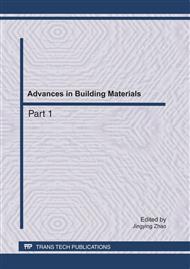p.1679
p.1685
p.1690
p.1694
p.1699
p.1705
p.1709
p.1714
p.1719
Study on Section Shape and Support Parameters of Guanjiao Tunnel under Carbonaceous Slate Stratum of the 2nd Line between Xining and Golmud
Abstract:
Guanjiao tunnel being reconstructed is the key engineering in the 2nd line between Xingning and Golmud. It is 32.645km long. Carbonaceous slate stratum thereinto is nearly 300m long. The rock mass was suffered tectonic movement and crushed, and its physical and mechanical properties are poor. So large deformation will occur while tunnelling under high horizontal tectonic stress. Numerical simulation along with field experiments were utilized to study the mechnical effect of tunnel section shape. Two kinds of section shapes were considered, that are horseshoe-shaped section and large curvature wall, quasi-circle-shape section. Results show that quasi-circle-shape section could effectively lessen the deformation of tunnel and minish stress concentration of support. Field experiments of different support forms were also conducted. Support forms include Grid steel frame (4×ф22mm)with 0.5m span, I 20a steel frame with 0.67m span and I 20a steel frame with 0.5m span. Pressure of surrounding rock, axial force of anchor, stress of steel frame and shotcrete under different support form were measured and analysed. Because composite lining was adopted in the tunnel, the contact pressure shared by secondary lining and stress of molded concrete under different primary support stiffness were also analysed. Results showed stress of support are rational under support form of I20a. Deformation of tunnel measured in situ under different support forms showed that support form of I20a could control deformation of surrounding rock. Synthetically considering the above and economic benefit, support form of I 20a steel frame with 0.67m span was deemed to be optimal in carbonaceous slate stratum. That could offer engineering experience to tunneling in soft rock under high tectonic stress.
Info:
Periodical:
Pages:
1699-1704
Citation:
Online since:
May 2011
Authors:
Price:
Сopyright:
© 2011 Trans Tech Publications Ltd. All Rights Reserved
Share:
Citation:


